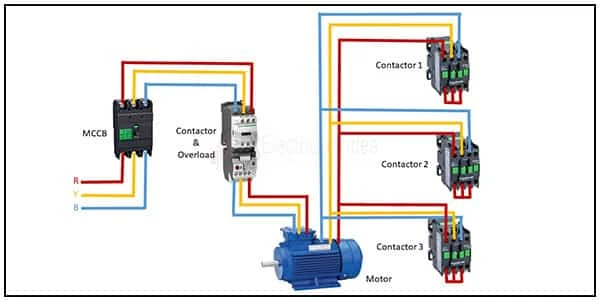Slip Ring Motor Connection Diagram:
This diagram shows how to make Slip ring motor connection Diagram. In this circuit, we use an MCCB ( Molded Case Circuit Breaker ), a contactor and overload, a 3-phase motor, and three other magnetic contactors. First, we need to connect MCCB with a power source, then connect the contactor and overload, then connect the motor, and again connect all contactors.
Diagram of 3 Phase Motor wiring:
Components Need for this Project:
You can get the components from any of the sites below:
- MCCB [See Buy Click Amazon]
- Contactor [See Buy Click Amazon]
- Overload [See Buy Click Amazon]
- 3 Phase Motor [See Buy Click Amazon]
Read Also:
Components used to make the Slip ring motor connection:
01. MCCB
 |
| Fig 2: MCCB |
MCCB (Molded Case Circuit Breakers) is a Required Component of Electrical Systems, Providing Overload Protection And Short-Circuit Protection. Circuit breakers are electrical devices that offer protection against fault currents. Molded Case Circuit Breakers (MCCB) or Molded Case Circuit Breakers Use air as The Dielectric Medium to Break a Circuit. Air Has a Low Dielectric Strength as Opposed to Other Mediums Which is why it is Used for Protection in low-Voltage Circuits. In Most Cases, Molded Case Circuit Breakers are installed in the Main Power Distribution Board of a Facility, Allowing the system to be easily shut Down When Necessary.
02. Contactor
 |
| Fig 3: Contactor |
A magnetic contactor is an electrical device used for load control, automation, and protection. It is much like a magnetic reel. However, relays are generally used for low power and voltage, on the other hand, when we think of high power, these heavy-duty contractors only come to mind. It basically works by switching the load on and off. It has 3 terminals whose inputs are denoted as L1, L2, L3, and outputs as T1, T2, and T3. The circuit of the load is made in automation mode or protection using auxiliary contacts. It has two types of terminals. 1) Normally Open (NO). 2) Normally Closed (NC)
03. Overload
 |
| Fig 4: Overload |
Overload relays are often used to protect the motor from excessive current flow. Overload relays are used to protect the motor from overheating. Besides some specific faults such as phase to phase, phase to ground, etc. overload relay provides protection to the motor. A thermal overload relay works on the principle of bimetallic strip electro-thermal characteristics. When the bimetallic heats up, the trip function in the overload relay turns on and disconnects the power supply to the contactor coil, thus tripping the overload relay and breaking the motor current and saving the motor.
04. 3 Phase Motor
 |
| Fig 5: 3 Phase Motor |
A Three-Phase Motor is an Electric Motor That Typically Receives its Power From a Three-Phase System (three-phase current) This can be realized via a Three-Phase Mains Supply or a Frequency Inverter. Three-Phase Motors are Available as Synchronous and Asynchronous Motors. Three Phase Alternating Current Power Motor is Economical to Supply Power to the data Center Since it Requires Less Conductor Material to Supply Electricity. This Explains Why 3 Phase Alternating Current Motor is Used in Electric Transmission, Generation, and Distribution in Most Countries Worldwide.
Thank You for visiting the website. Keep visiting for more Updates.


Post a Comment
Do leave your comments